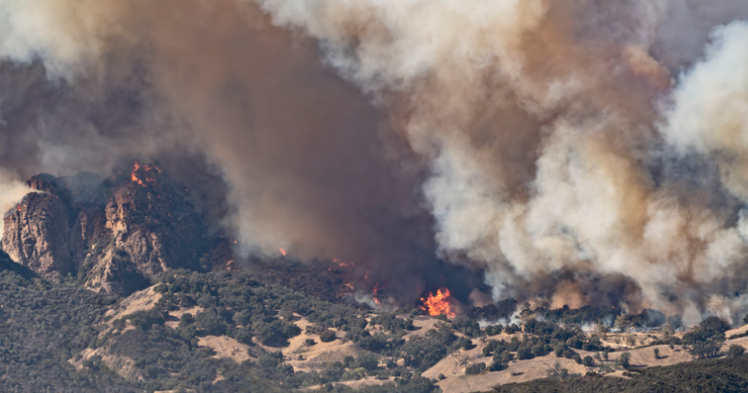September 16, 2024: Southern California Wildfires Trigger Evacuations and Air Quality Warnings
Southern California is facing several wildfires that have ignited amidst a prolonged heatwave, resulting in compulsory evacuations and declining air quality throughout the area. The Line Fire in San Bernardino County has swiftly grown to over 21,000 acres, endangering residential neighborhoods and essential infrastructure. Firefighters are battling difficult circumstances, including elevated temperatures and changing winds, which have hindered containment efforts. Evacuation mandates are established for numerous communities, and residents are encouraged to comply immediately to ensure their protection.
Alongside the immediate dangers posed by the flames, the wildfires have profoundly affected air quality across Southern California. Health authorities have released advisories cautioning of heightened levels of particulate matter and pollutants, which can worsen respiratory ailments. Residents, especially those with pre-existing health concerns, are urged to restrict outdoor activities and employ air filtration devices indoors. The combination of extreme heat and poor air quality has also overwhelmed local healthcare institutions, as they cope with an influx of patients suffering from heat-related conditions and respiratory difficulties.
Southern California Wildfires: Evacuations and Air Quality Alerts
On September 16, 2024, Southern California faced a critical environmental crisis as wildfires rapidly spread across the region. These wildfires, fueled by dry conditions and high winds, prompted swift evacuations and raised alarms about deteriorating air quality. The situation has become increasingly urgent as communities grapple with the devastating effects of these natural disasters.
The Emergence of Wildfires
Wildfires in Southern California are not uncommon during the dry summer and early fall months. However, the intensity and speed at which these particular fires spread caught many officials off guard. Factors such as prolonged drought, high temperatures, and strong Santa Ana winds have created a perfect storm for wildfire outbreaks. As flames engulfed thousands of acres, firefighting resources were rapidly mobilized to combat the inferno threatening homes and ecosystems.
Evacuations Underway
In response to the fast-moving fires, local authorities instituted evacuation orders for several communities in affected areas. Residents were urged to leave their homes immediately as the flames approached, and regional shelters were opened to provide refuge for those displaced. Emergency services collaborated with local organizations to ensure that evacuees received necessary support, including food, medical assistance, and information on recovery resources.
Impact on Air Quality
The wildfires have had a significant negative effect on air quality throughout the region. Smoke and particulate matter have traveled far beyond the immediate fire zones, leading to health advisories for surrounding areas. The South Coast Air Quality Management District issued alerts, advising residents, especially those with preexisting respiratory conditions, to limit outdoor activities and remain indoors as much as possible. Officials emphasized the importance of using air purifiers and keeping windows closed to mitigate exposure.
The Role of Firefighting Efforts
Firefighting crews worked tirelessly to control the wildfires, employing a range of tactics, including controlled burns and aerial water drops. However, the unpredictability of the flames, exacerbated by unpredictable weather conditions, has posed significant challenges. Firefighters not only faced the immediate danger of the flames but also the risk of falling trees and other hazards in the rugged terrain. Despite their effort and dedication, containment of the fires has been slow, underscoring the ongoing battle against these destructive natural events.
Community Support and Preparedness Measures
In times of such crises, community support often becomes a source of strength for those affected. Local organizations, volunteers, and neighboring communities have rallied to provide assistance. Donations in the form of food, clothing, and basic necessities have poured in to help those who have evacuated. Additionally, fire safety education initiatives have gained traction, emphasizing the importance of preparedness in mitigating risks associated with wildfires in the future.
Looking Ahead: Climate Change and Fire Seasons
The increasing frequency and intensity of wildfires in Southern California and throughout the western United States have sparked discussions about climate change and its impact on wildfire behavior. Experts warn that shifting weather patterns and prolonged drought conditions could lead to longer, more destructive fire seasons. As communities strive to adapt, they are also calling for enhanced firefighting resources, better evacuation protocols, and more significant investments in climate resilience strategies.
Conclusion
The wildfires that erupted in Southern California on September 16, 2024, serve as a stark reminder of the ongoing dangers posed by such natural disasters. With evacuations in place and air quality alerts issued, the impact on communities cannot be understated. As firefighting efforts continue and residents seek refuge, the importance of preparation and community support remains evident. Moving forward, addressing the underlying factors contributing to these increasingly severe wildfire events will be crucial for safeguarding the health and well-being of those living in fire-prone areas.
FAQs
What should I do if I receive an evacuation order due to wildfires?
If you receive an evacuation order, it is crucial to follow the guidance of local authorities. Prepare an emergency kit, including essential documents, medications, and personal items. Leave as soon as possible and follow designated evacuation routes.
How can I protect my home from wildfires?
To protect your home, create a defensible space by clearing flammable materials from around your property, maintaining landscaping, and ensuring that your home is equipped with fire-resistant materials. Regularly review and update your emergency plans.
What resources are available for evacuees during wildfires?
Evacuees can typically find resources at local shelters established by the Red Cross and similar organizations. They may also receive support through community aid programs that provide food, clothing, and other necessities.
How does wildfire smoke affect air quality?
Wildfire smoke can contain harmful particulate matter that affects air quality, potentially leading to respiratory issues and other health complications. It is advisable to limit outdoor activities during smoke events and to use air purification systems indoors.
What long-term solutions are being considered for wildfire prevention?
Long-term solutions for wildfire prevention include improving forest management practices, investing in firefighting resources, and enhancing community preparedness through education and infrastructure improvements.

